2019 MERCEDES-BENZ S CLASS steering wheel
[x] Cancel search: steering wheelPage 438 of 578
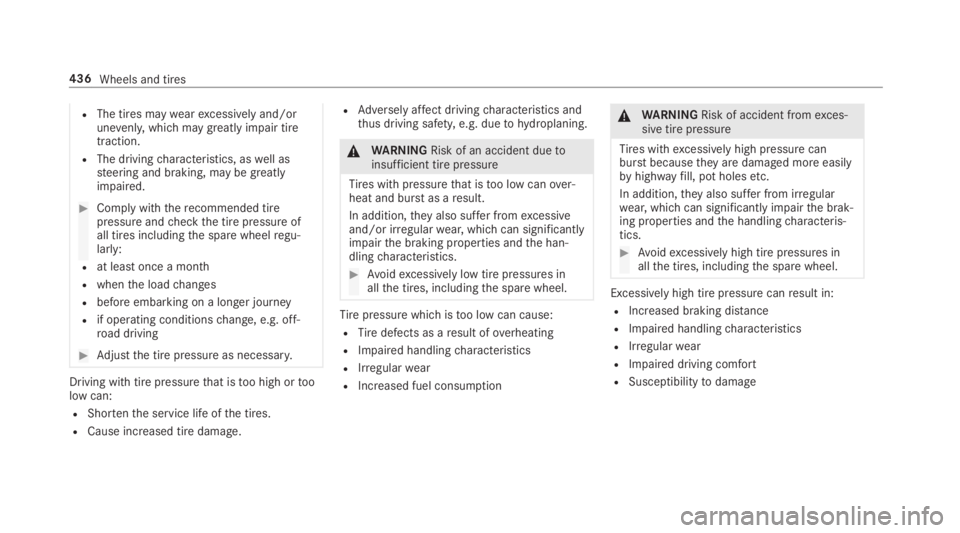
RThe tires maywearexcessively and/orunevenly,which maygreatlyimpair tiretraction.
RThe drivingcharacteristics, aswell assteering and braking, may be greatlyimpaired.
#Comply withtherecommended tirepressure andcheckthe tire pressure ofall tires includingthe spare wheelregu‐larly:
Rat least once a month
Rwhenthe loadchanges
Rbefore embarking on a longer journey
Rif operating conditionschange, e.g. off-road driving
#Adjustthe tire pressure as necessary.
Driving withtire pressurethat istoo high ortoolow can:
RShortenthe service life ofthe tires.
RCause increased tire damage.
RAdversely affect drivingcharacteristics andthus driving safety,e.g. dueto hydroplaning.
&WARNINGRisk of an accident duetoinsufficient tire pressure
Tires with pressurethat istoo low canover‐heat and burstas aresult.
In addition,theyalso suffer fromexcessiveand/or irregularwear, which can significantlyimpairthe braking properties andthe han‐dlingcharacteristics.
#Avoidexcessively low tire pressures inallthe tires, includingthe spare wheel.
Tirepressure which istoo low can cause:
RTiredefects as aresult ofoverheating
RImpaired handlingcharacteristics
RIrregularwear
RIncreased fuel consumption
&WARNINGRisk of accident fromexces‐sive tire pressure
Tires withexcessively high pressure canburst becausetheyare damaged more easilybyhighwayfill, pot holesetc.
In addition,theyalso suffer from irregularwear, which can significantly impairthe brak‐ing properties andthe handlingcharacteris‐tics.
#Avoidexcessively high tire pressures inallthe tires, includingthe spare wheel.
Excessively high tire pressure canresult in:
RIncreased braking distance
RImpaired handlingcharacteristics
RIrregularwear
RImpaired driving comfort
RSusceptibilitytodamage
436Wheels and tires
Page 443 of 578

ing condition (→page 437). Observethenotes on tiretemperature (→page 435).
%Thevalues displayed inthe multifunction dis‐play may deviate fromthose ofthe tire pres‐suregauge astheyrefertosea level.Athighaltitudes,the tire pressurevalue indicatedbya pressuregauge are higherthanthoseshownbythe on-board computer. Inthiscase, do notreducethe tire pressure.
Make suretoobservethefollowing furtherrela‐ted subject:
RNotes on tire pressure (→page 435)
Restartingthe tire pressure monitoring sys‐tem
Requirements:RTherecommended tire pressure is correctlysetfortherespective operating condition oneach ofthefour wheels (→page 435).
Restartthe tire pressure monitoring system inthefollowing situations:
RThe tire pressure haschanged.
RThe wheels or tires havebeenchanged ornewly installed.
On-board computer:
,Service.Tires
#Swipe downwards onTouch Control ontheleft-hand side ofthesteering wheel.TheUse Current Pressures as New Refer-ence Values?message is shown inthe multi‐function display.
#Press�vtoconfirmtherestart.TheRun Flat Indicator Restartedmessage isshown inthe multifunction display.
Currentwarning messages are deleted andthe�wyellowwarning lamp goes out.
Afteryou havedrivenfor afew minutes,thesystemcheckswhetherthe current tire pres‐sures are withinthe specifiedrange. The cur‐rent tire pressures arethen accepted asref‐erencevalues and monitored.
Make suretoobservethefollowing furtherrela‐ted subject:
RNotes on tire pressure (→page 435)
Radio equipment approval ofthe tire pres‐sure monitoring system
Radio equipment approval numbers
CountryRadio type approval number
Canada IC: 2546A-GG4T
IC: 2546A-DG6W2D4
IC: 2546A-MC34MA4
Le présent appareil est conformeaux CNR d'Industrie Canadaapplicables aux appareilsradioexempts de licence. L'exploita‐tion est autorisée aux deux con‐ditions suivantes:
(1) l'appareil ne doit pas produirede brouillage,et
(2) l'utilisateur de l'appareil doitacceptertout brouillageradioé‐lectrique subi, même si le
brouillage est susceptible d'encompromettrelefonctionnement.
Wheels and tires441
Page 444 of 578

CountryRadio type approval number
USAFCC ID: MRXGG4T
FCC ID: MRXDG6W2D4
FCC ID: MRXMC34MA4
This device complies withPart15ofthe FCCRules. Operation issubjecttothefollowing two con‐ditions:
(1) This device may not causeharmful interference, and
(2) This device mustaccept anyinterferencereceived, includinginterferencethat may cause
undesired operation.
Loadingthevehicle
Notes onTireand Loading Information plac‐ard
&WARNINGRisk of accident fromoverloa‐ded tires
Overloaded tires mayoverheat and burstas aconsequence. Overloaded tires can alsoimpairthesteering and handlingcharacteris‐tics and leadtobrakefailure.
#Observethe load-bearing capacity ofthe tires.
#The load-bearing capacity must be atleast halfthe gross axleweightrating ofthevehicle.
#Neveroverloadthe tiresby exceedingthe maximum load.
TheTireand Loading Information placard is onthe B-pillar onthe driver's side ofthevehicle.
1Tireand Loading Information placard
442Wheels and tires
Page 513 of 578
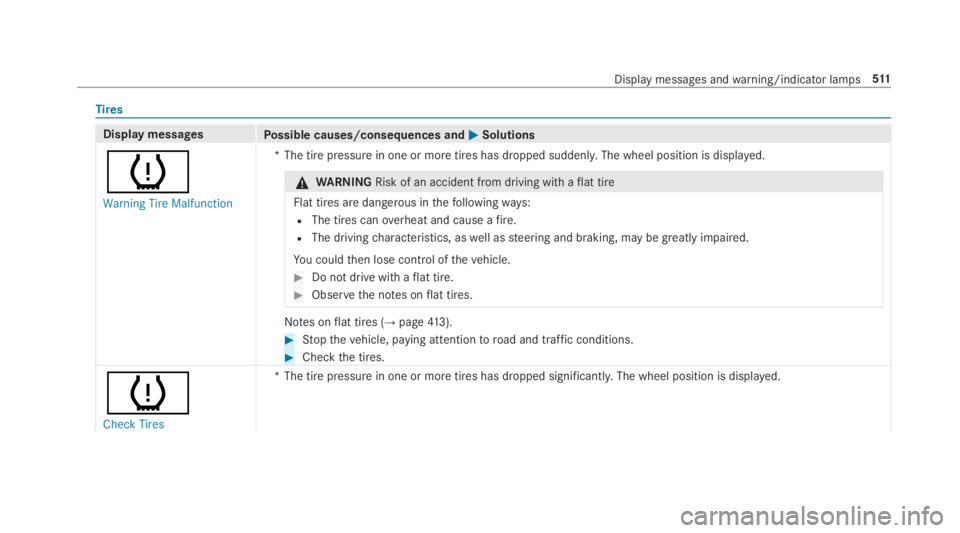
Tires
Display messagesPossible causes/consequences and�P�PSolutions
�w
Warning Tire Malfunction
*The tire pressure in one or more tires has dropped suddenly. The wheel position is displayed.
&WARNINGRisk of an accident from driving withaflat tire
Flat tires are dangerous inthefollowingways:
RThe tires canoverheat and cause afire.
RThe drivingcharacteristics, aswell assteering and braking, may be greatly impaired.
You couldthen lose control ofthevehicle.
#Do not drive with aflat tire.
#Observethe notes onflat tires.
Notes onflat tires (→page413).
#Stopthevehicle, paying attentiontoroad and traffic conditions.
#Checkthe tires.
�w
Check Tires
*The tire pressure in one or more tires has dropped significantly.The wheel position is displayed.
Display messages andwarning/indicator lamps511
Page 514 of 578
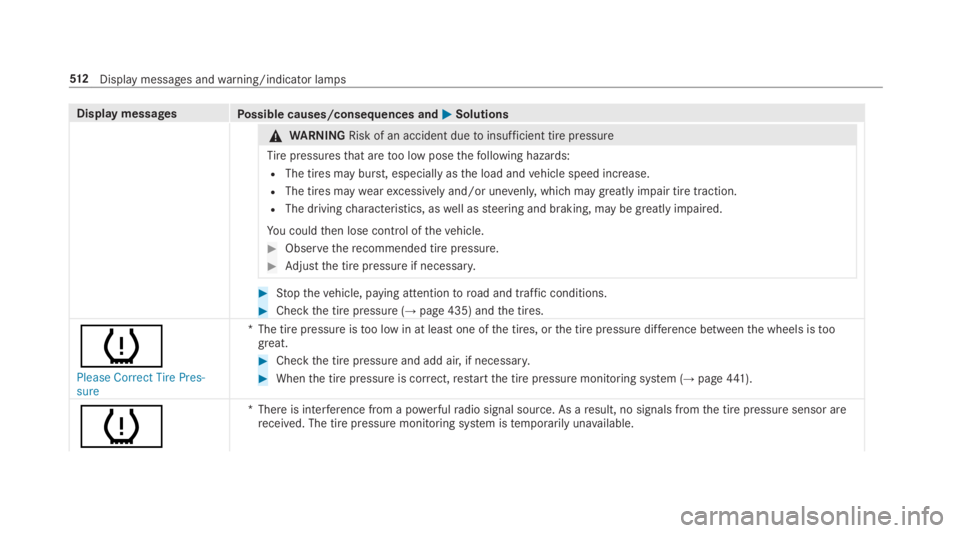
Display messagesPossible causes/consequences and�P�PSolutions
&WARNINGRisk of an accident duetoinsufficient tire pressure
Tirepressuresthat aretoo low posethefollowing hazards:
RThe tires may burst, especially asthe load andvehicle speed increase.
RThe tires maywearexcessively and/or unevenly,which may greatly impair tire traction.
RThe drivingcharacteristics, aswell assteering and braking, may be greatly impaired.
You couldthen lose control ofthevehicle.
#Observetherecommended tire pressure.
#Adjustthe tire pressure if necessary.
#Stopthevehicle, paying attentiontoroad and traffic conditions.
#Checkthe tire pressure (→page 435) andthe tires.
�w
Please Correct Tire Pres-sure
*The tire pressure istoo low in at least one ofthe tires, orthe tire pressure difference betweenthe wheels istoogreat.
#Checkthe tire pressure and add air, if necessary.
#Whenthe tire pressure is correct,restartthe tire pressure monitoring system (→page441).
�w
*There is interference from a powerfulradio signal source. As aresult, no signals fromthe tire pressure sensor arereceived. The tire pressure monitoring system istemporarily unavailable.
512Displaymessages andwarning/indicator lamps
Page 515 of 578
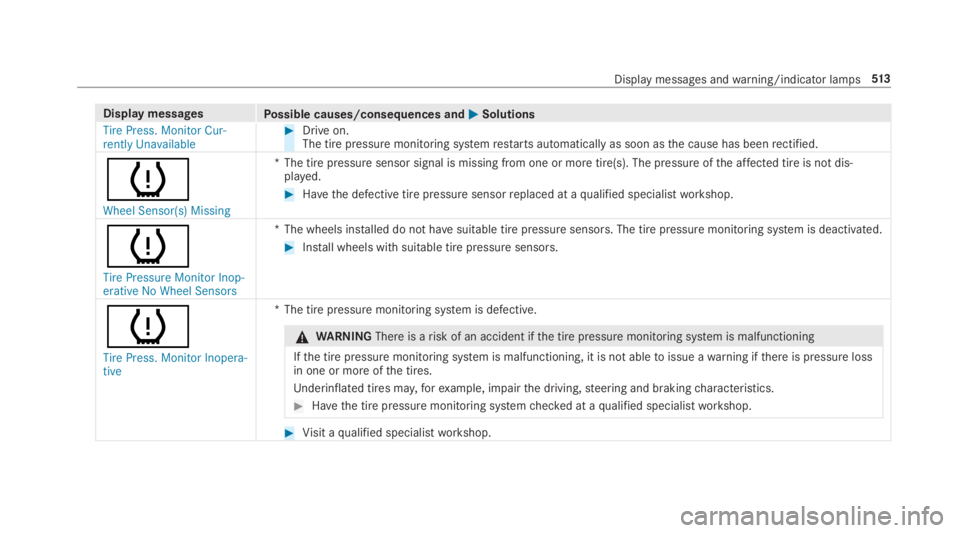
Display messagesPossible causes/consequences and�P�PSolutions
Tire Press. Monitor Cur-rently Unavailable
#Drive on.The tire pressure monitoring systemrestarts automatically as soon asthe cause has beenrectified.
�w
Wheel Sensor(s) Missing
*The tire pressure sensor signal is missing from one or more tire(s). The pressure ofthe affected tire is not dis‐played.
#Havethe defective tire pressure sensorreplaced at aqualified specialistworkshop.
�w
Tire Pressure Monitor Inop-erative No Wheel Sensors
*The wheels installed do not havesuitable tire pressure sensors. The tire pressure monitoring system is deactivated.
#Install wheels with suitable tire pressure sensors.
�w
Tire Press. Monitor Inopera-tive
*The tire pressure monitoring system is defective.
&WARNINGThereis arisk of an accident ifthe tire pressure monitoring system is malfunctioning
Ifthe tire pressure monitoring system is malfunctioning, it is not abletoissue awarning ifthere is pressure lossin one or more ofthe tires.
Underinflated tires may,forexample, impairthe driving,steering and brakingcharacteristics.
#Havethe tire pressure monitoring systemchecked at aqualified specialistworkshop.
#Visit aqualified specialistworkshop.
Display messages andwarning/indicator lamps513
Page 527 of 578
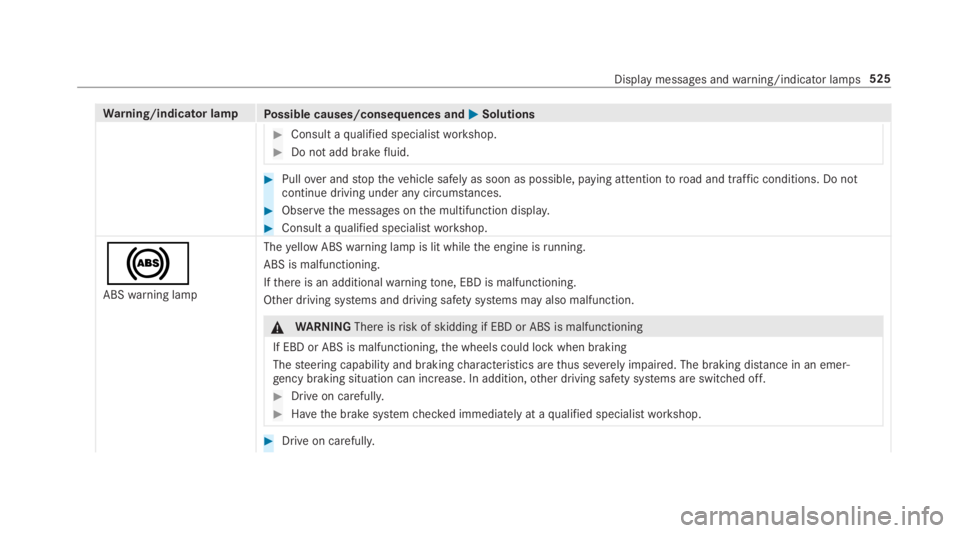
Warning/indicator lampPossible causes/consequences and�P�PSolutions
#Consult aqualified specialistworkshop.
#Do not add brakefluid.
#Pullover andstopthevehicle safely as soon as possible, paying attentiontoroad and traffic conditions. Do notcontinue driving under any circumstances.
#Observethe messages onthe multifunction display.
#Consult aqualified specialistworkshop.
�%
ABSwarning lamp
Theyellow ABSwarning lamp is lit whilethe engine isrunning.
ABS is malfunctioning.
Ifthere is an additionalwarningtone, EBD is malfunctioning.
Other driving systems and driving safety systems may also malfunction.
&WARNINGThereisrisk of skidding if EBD or ABS is malfunctioning
If EBD or ABS is malfunctioning,the wheels could lock when braking
Thesteering capability and brakingcharacteristics arethus severelyimpaired. The braking distance in an emer‐gency braking situation can increase. In addition,other driving safety systems are switched off.
#Drive on carefully.
#Havethe brake systemchecked immediately at aqualified specialistworkshop.
#Drive on carefully.
Display messages andwarning/indicator lamps525
Page 538 of 578
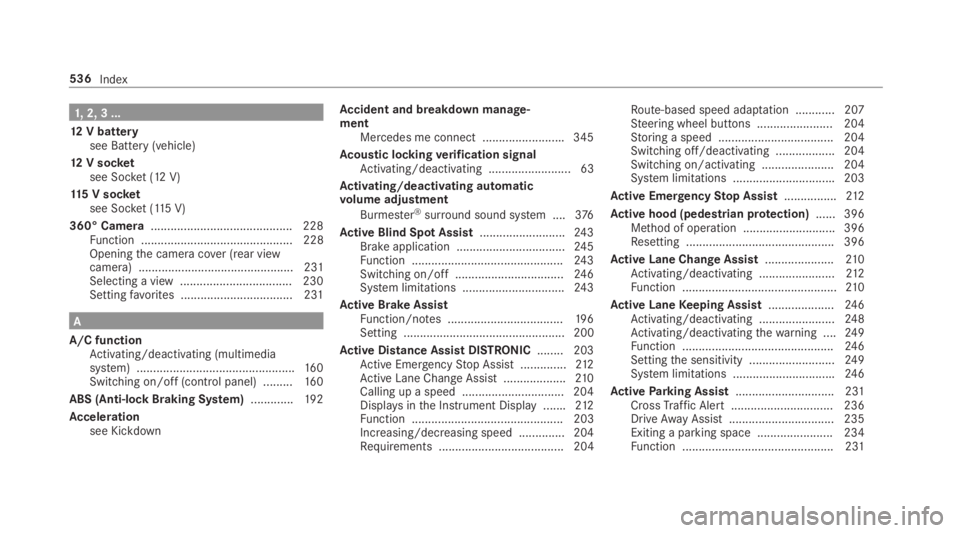
1,2, 3 ...
12V batterysee Battery (vehicle)
12V socketsee Socket (12 V)
115 V socketsee Socket (115V)
360° Camera........................................... 228Function .............................................. 228Openingthe camera cover (rear viewcamera) ............................................... 231Selecting a view .................................. 230Settingfavorites ..................................231
A
A/C functionActivating/deactivating (multimediasystem) ................................................16 0Switching on/off (control panel) .........16 0
ABS (Anti-lock Braking System).............192
Accelerationsee Kickdown
Accident and breakdown manage‐mentMercedes me connect .........................345
Acoustic lockingverification signalActivating/deactivating ......................... 63
Activating/deactivating automaticvolume adjustment
Burmester®surround sound system ....376
Active Blind Spot Assist..........................24 3Brake application .................................24 5Function ..............................................24 3Switching on/off .................................24 6System limitations ...............................243
Active Brake AssistFunction/notes ...................................19 6Setting ................................................. 200
Active Distance Assist DISTRONIC........ 203Active EmergencyStop Assist ..............212Active Lane Change Assist...................210Calling up a speed ...............................204Displays inthe Instrument Display .......212Function .............................................. 203Increasing/decreasing speed .............. 204Requirements ...................................... 204
Route-based speed adaptation ............207Steering wheel buttons ....................... 204Storing a speed ................................... 204Switching off/deactivating .................. 204Switching on/activating ......................204System limitations ...............................203
Active EmergencyStop Assist................212
Active hood (pedestrian protection)...... 396Method of operation ............................396Resetting ............................................. 396
Active Lane Change Assist.....................210Activating/deactivating .......................212Function ...............................................210
Active LaneKeeping Assist....................24 6Activating/deactivating .......................248Activating/deactivatingthewarning ....24 9Function ..............................................24 6Settingthe sensitivity ..........................24 9System limitations ...............................246
ActiveParking Assist.............................. 231CrossTraffic Alert ............................... 236DriveAwayAssist................................ 235Exiting a parking space .......................234Function .............................................. 231
536Index